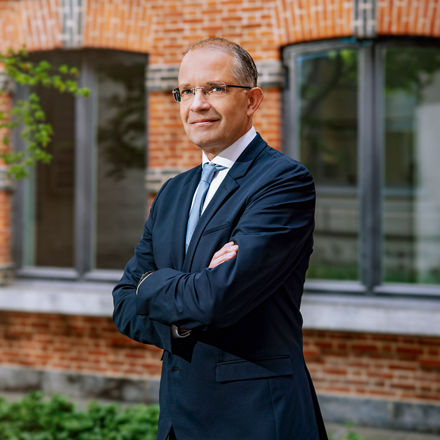Up to early 2022, biogas cost twice as much as natural gas and therefore was hardly competitive. Since then, the price of natural gas has increased drastically—and biogas is seen as a viable alternative. Will the Russian invasion in Ukraine ironically help biogas make a breakthrough?
Harmen Dekker To some extent, maybe. However, biogas or biomethane has already been gainingattention for some time. At the EBA, we have been relentlessly knocking on the doors of political decision-makers all over Europe. One year before the crisis started, there was already an increased interest in biomethane—for two reasons. One is the European Commission’s desire to fulfill its “Fit for 55” target aiming at a reduction of greenhouse gas emissions by at least 55 percent within the next seven years. But biomethane also gained more attention from companies that are committing to the Paris agreement and need to fulfill their climate goals.
The EU Commission wants the biogas sector to cover 20 percent of current EU gas imports from Russia by 2030—that is 35 billion cubic meters. Is this a realistic goal?
Absolutely. We’ve compared all the studies of biogas within Europe over the past few years—and we’ve found a steady increase of the total sustainable potential, which will add up to 167 billion cubic meters by 2050. And we do not even take into account all the biomass or manure that is available. Looking toward 2030, there is no doubt in my mind that we can make it if the conditions are right. Just to give you an idea, for 35 billion cubic meters we need roughly 5,000 biogas plants. Germany after 2006 managed to build 6,000 plants in nine years’ time.
Which are the biggest bottlenecks?
First, permission procedures across Europe for building a biogas plant can take ages. On average, it takes up to four years, which in this time of need for energy security is not acceptable. Secondly, we need to have a market where methane can flow freely between countries. We need to make sure that the borders are being opened—in the same way as the market for electricity. Thirdly, we need more personnel dedicated to renewable energy. Besides all this, we will need to mobilize the sustainable feedstock and ensure a stable regulatory framework across Europe.
Until now the quality of biomethane has not been the same in different countries—which makes cross-border trading difficult.
Well, if we take natural gas from Norway, Russia or the Netherlands there is a difference in quality as well. With biomethane we can solve that problem easily: Biogas plants can produce different qualities. For example, membranes can take out the CO2 to certain levels and make the biomethane extremely pure. In any case, we should improve the harmonization between different legislations in countries to make sure that we can speed up production.

»Permission procedures across Europe are cumbersome and far too long«
Harmen Dekker head of the European Biogas Association EBA
Nobody objects to renewable energy in general, but when it comes to building windmills, solar parks or biogas plants in their neighborhood people are taking to the streets. How can this problem be solved?
The European Commission is paying extra attention to this situation. Permission procedures across Europe are cumbersome and far too long. In times of energy and climate crisis we need to rethink our approach to this. In addition, our advice to all project developers and farmers is: Make sure that you involve your community! One plant can support a village of 3,000 households with biomethane at a very cheap price compared to current natural gas. So it is green, it is cheaper, and it is local. People can even bring their own organic waste if it fits the design of the plant.
And what about the smell?
At the beginning of the biogas industry, digestate was sometimes not covered, and if a biogas plant is not operated well, you can get such problems. But the industry has evolved and professionalized.
Critics of biogas use complain that in many places energy crops such as corn are used, which displace plants for food and feed. The positive climate effect is thus reduced. Isn’t there some truth in that?
The issue is about how do we do our farming. We are not displacing food and feed. We do not want to do anything detrimental to either the soil or the land use such as monocropping. When you look at all the relevant studies, they do not include any additional crops that require a change in land use.
Furthermore, the biogas industry depends on manure, and thus a substantial amount of livestock farming, in order to have enough substrate for its plants. How will this work in a world with people consuming less animal products?
Eating meat or not is a decision which is outside the control of our industry. To curb emissions it makes sense to use animal manure as feedstock. At this moment less than five percent of manure is being utilized. Should there be less manure other sustainable feedstocks can be used. We will adapt if people or politics are moving away from livestock farming.
Are you thinking of municipal waste or wastewater?
Indeed, those are good examples of usable feedstocks. We are advocating for all the wastewater plants of a certain size within Europe to be changed to an anaerobic system because it’s cheaper than current methods and it creates energy at the same time. The same applies to the organic fraction of municipal waste as sustainable feedstock.
Will the EU taxonomy—a classification system establishing a list of environmentally sustainable economic activities—serve as a driver for this process?
Yes, the taxonomy is important, even though after including natural gas and nuclear power it has lost some of its shine. Biomethane is included as well, but what we are still missing is that pipelines are seen as a green investment when biogas plants can be connected to them.
Today Europe occupies a leading position with regard to production and use of biogas. Will other parts of the world catch up?
I foresee slow progress at first, but it will accelerate. In Asia, for example, there is huge potential for sustainable biomethane. However, in many countries fossil energy is still being supported by the government, for example through subsidy schemes. If you reshape that and introduce frameworks that foster more sustainable forms of energy, that will certainly help. In other parts of the world like America, people have already discovered what renewable natural gas can bring. In many places around the world, communities would like to have local forms of energy for energy security. Biogas fits in perfectly here because it’s a stable source of energy. Unlike wind or solar, we are producing every second of the day. And because it’s local, you get the circularity that we need for the future. Technology-wise Europe is in a strong position, be it the building of biogas domes or covering roofs or the technologies for purifying the gas.
In the wind and solar industry Europe saw its technological advantage dwindle quickly. Today a lot of the technologies for renewable energy come from China. Do you see the same danger for the European biogas industry?
On solar we’ve lost our edge a little bit, haven’t we? But it also has to do with the resources you need to produce solar panels, batteries and so on. Biogas is different. We do not have to mine materials for solar panels, and we do not have to make batteries. Our resource is the feedstock that is lying around. And actually, that is our greatest strength. Of course we see technologies being developed in other countries. Perfect! Let’s go for that. We need every bit of technology being developed locally to make sure that we can produce a renewable source of electricity or gas.
Biogas can also be used to extract CO2. Combined with hydrogen, you receive methane or natural gas that can be used not only as a source of energy but also as an input for chemical processes. Does this chain of reaction play a vital role in your strategies?
Yes, I foresee a big future for this, because if you produce electricity via wind and solar you have peak supply. You can’t do anything with it unless you transfer it immediately to hydrogen, which is okay. But if you have no gas pipeline connected to that, what are you going to do with it? The best way to store your peak load is as renewable natural gas, because there we have an extensive grid throughout Europe. The biogenic CO2 coming from our biomethane production is a perfect way to ensure that we can capture the green electricity that we have in surplus at times and then transfer it and store it in our “e-methane” gas distribution system.
Do you see a risk that once the price for natural gas goes down again the boost for biogas will fade away and people will turn back to fossil fuels?
Maybe. However, the price of futures for natural gas jumps up and down. We used to have prices around 20 euros per megawatt hour. Today those prices have increased more than tenfold. If you look at 2025, futures are around 80 euros. In any case, it is expected that the price of natural gas will stay higher than we’ve been used to. We should use our time to develop the two most renewable gases we have: green hydrogen—and biomethane.


